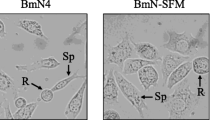Summary
A gypsy moth cell line, IPLB-LdEIta, maintained under various conditions was tested for susceptibility to and productivity of two baculoviruses, the Autographa californica nucleopolyhedrovirus (AcMNPV) and Lymantria dispar nucleopolyhedrovirus (LdMNPV). The results suggest that cells maintained in serum-containing medium (modified TC100) were more susceptible (on the basis of titers in an endpoint assay) to LdMNPV than cells maintained in a serum-free medium (ExCell™ 400). Such a difference was not apparent with AcMNPV. Similarly, little difference existed in the proportion of cells containing occlusion bodies (OBs) a wk after inoculation with AcMNPV (i.e., the percent infected) in any LdEIta strains, although one combination of cells and medium (cells maintained in ExCell 400 but infected in TC100) showed a lower percent infection with LdMNPV. Even though the percentage of cells infected varied little, the number of OBs produced varied by 3 logs with AcMNPV and 11/2 logs with LdMNPV. In each case, cells normally grown in ExCell 400 and infected in the same medium produced the lowest number of OBs. However, productivity was improved when cells normally grown in ExCell 400 were infected in TC100. Even more interesting was that cells normally grown in TC100 produced more AcMNPV OBs when infected in ExCell 400 medium. This suggests that changing culture medium (regardless of the normal maintenance medium) can stimulate virus production. In addition to examining virus productivity in LdEIta cells in both serum-containing and serum-free media, I also tested a strain maintained at low temperature (17° C) for over a yr. This maintenance protocol was not detrimental for LdMNPV productivity and was slightly stimulatory for production of AcMNPV.
Similar content being viewed by others
References
Betenbaugh, M. J.; Balog, L.; Lee, P.-S. Production of recombinant proteins by baculovirus-infected gypsy moth cells. Biotechnol. Prog. 7:462–467; 1991.
Chen, Q.; Mcintosh, A. H.; Yu, Z., et al. The replication of Autographa californica baculovirus (AcMNPV) in two lepidopteran cell lines grown in serum-free media. J. Invertebr. Pathol. 62:216–219; 1993.
Deutschmann, S. M.; Jäger, V. Optimization of the growth conditions of Sf21 insect cells for high-density perfusion culture in stirred-tank bioreactors. Enzyme Microbial Technol. 16:506–512; 1994.
Gardiner, G. R.; Stockdale, H. Two tissue culture media for production of lepidopteran cells and nuclear polyhedrosis viruses. J. Invertebr. Pathol. 25:363–370; 1975.
Goodwin, R. H.; Adams, J. R. Nutrient factors influencing viral replication in serum-free insect cell line culture. In: Kurstak, E.; Maramorosch, K.; Dübendorfer, A., ed. Invertebrate systems in vitro. Amsterdam: Elsevier; 1980:493–509.
Hink, W. F.; Strauss, E. Replication of alfalfa looper nuclear polyhedrosis virus in the Trichoplusia ni (TN-368) cell line. Invertebrate tissue culture, applications in medicine, biology, and agriculture 1976:369–374.
Hink, W. F.; Thomsen, D. R.; Davidson, D. J., et al. Expression of three recombinant proteins using baculovirus vectors in 23 insect cell lines. Biotechnol. Prog. 7:9–14; 1991.
Horton, H. M.; Burand, J. P. Saturable attachment sites for polyhedron-derived baculovirus on insect cells and evidence for entry via direct membrane fusion. J. Virol. 67:1860–1868; 1993.
King, G. A.; Daugulis, A. J.; Faulkner, P., et al. Recombinant β-galactosidase production in serum-free medium by insect cells in a 14-L airlift bioreactor. Biotechnol. Prog. 8:567–571; 1992.
Lynn, D. E. Methods for the development of cell lines from insects. J. Tissue Culture Meth. 12:23–29; 1989.
Lynn, D. E. A BASIC computer program for analyzing endpoint assays. BioTechniques 12:880–881; 1992a.
Lynn, D. E. Improved efficiency in determining the titer of the Autographa californica baculovirus nonoccluded virus. BioTechniques 13:282–285; 1992b.
Lynn, D. E. Enhanced infectivity of occluded virions of the gypsy moth nuclear polyhedrosis virus for cell cultures. J. Invertebr. Pathol. 63:268–274; 1994.
Lynn, D. E.; Dougherty, E. M.; McClintock, J. T.; Loeb, M. Development of cell lines from various tissues of Lepidoptera. In: Kuroda, Y.; Kurstak, E.; Maramorosch, K., ed. Invertebrate and fish tissue culture. Tokyo: Japan Scientific Societies Press; 1988:239–242.
Lynn, D. E.; Dougherty, E. M.; McClintock, J. T., et al. Comparative replication of Lymantria dispar nuclear polyhedrosis virus strains in three continuous-culture cell lines. Appl. Environ. Microbiol. 55:1049–1051; 1989.
Lynn, D. E.; Shapiro, M.; Dougherty, E. M. Selection and screening of clonal isolates of the abington strain of gypsy moth nuclear polyhedrosis virus. J. Invertebr. Pathol. 62:191–195; 1992.
Mairorella, B.; Inlow, D.; Shauger, A., et al. Large-scale insect cell-culture for recombinant protein production. Bio/Technology 6:1406–1410; 1988.
McKenna, K. K.; Shuler, M. L.; Granados, R. R. Increased virus production in suspension culture by a Trichoplusia ni cell line in serum-free media. Biotechnology Prog. 13:805–809; 1997.
Park, E. J.; Burand, J. P.; Yin, C. M. The effect of baculovirus infection on ecdysteroid titer in gypsy moth larvae (Lymantria dispar). J. Insect Physiol. 39:791–796; 1993.
Smith, G. E.; Summers, M. D.; Fraser, M. J. Production of human beta interferon in insect cells infected with a baculovirus expression factor. Mol. Cell. Biol. 3:2156–2165; 1983.
Wilkie, G. E. I.; Stockdale, H.; Pirt, S. J. Chemically-defined media for production of insect cells and viruses in vitro. Dev. Biol. Stand. 46:29–37; 1980.
Winstanley, D.; Crook, N. E. Replication of Cydia pomonella granulosis virus in cell cultures. J. Gen. Virol. 74:1599–1609; 1993.
Author information
Authors and Affiliations
Rights and permissions
About this article
Cite this article
Lynn, D.E. Comparison of cell line maintenance procedures on insect cells used for producing baculoviruses. In Vitro Cell.Dev.Biol.-Animal 35, 248–251 (1999). https://doi.org/10.1007/s11626-999-0068-7
Received:
Accepted:
Issue Date:
DOI: https://doi.org/10.1007/s11626-999-0068-7




